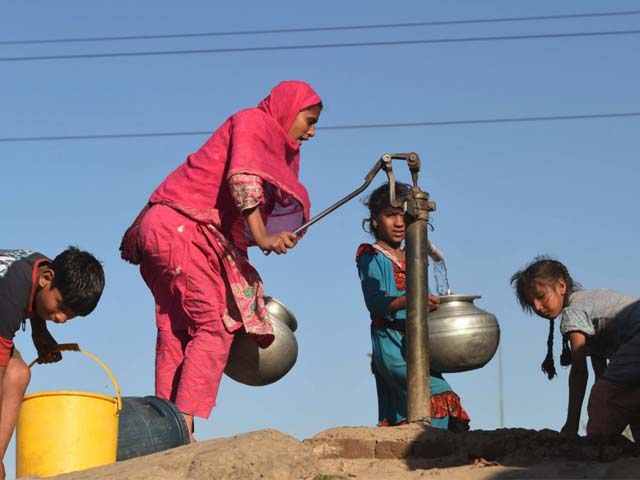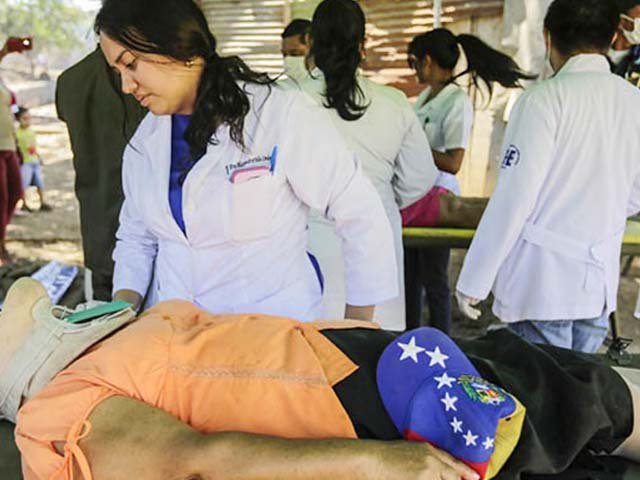
Pakistani Muslims slaughter animals at a mosque in Lahore on November 7, 2011 during the Eidul Azha celebrations. PHOTO: AFP
If Saudi Arabia and other Middle Eastern countries can practice safe and hygienic qurbani, why can’t Pakistan?
Our children who spend a sufficient amount of time with the sacrificial animals are most susceptible to the disease.
Amateur butchers with no skills, armed with sharp knives and cleavers of various sizes and shapes will once again see daylight on Eidul Azha.
These part-time novices can be seen swarming our cities during the wee hours of Eid. They are stationed at every nook and corner and seem trained in their craft of deception. In our quest to find the most reasonable butcher, we end up overlooking important factors such as hygiene and whether or not they are skilled enough to perform qurbani (slaughtering) the correct way. It is imperative that we keep such factors in mind before hiring butchers.
After mosques wrap up their respective morning Eid prayers, individuals rush to their homes to perform qurbani. But in the process to promptly perform this sacred responsibility, coupled with the onslaught of amateur one-time butchers, adequate standards of hygiene are severely compromised.
Nearly every home, backyard and roadside witnesses the act of slaughtering. Rivers of blood, due to numerous qurbanis, ultimately make their way into the drainage. In turn, the drainage systems get clogged. As it is, our drainage systems are not maintained and there is no efficient system either, thus streets and backyards are painted red and emanate a rancid smell.
Furthermore, animal hides, heads and discarded offal are a common sight on the roads, which attract all forms of scavengers from cats and dogs to crows, further adding to the already overflowing heap of filth in our neighbourhoods. This sets the stage for various zoonotic infections (infections transferred from animal to man).
Apart from the hygiene aspect, if the qurbani is not performed properly, dangerous diseases can be spread and contracted. The Crimean-Congo Haemorrhagic Fever (CCHF), a fatal disease caused by a virus maintained in the bodies of ticks (especially those of the genus Hyalomma) which are found on the skins of farm animals, has become a common disease. Individuals most susceptible to being bitten by these ticks include people who have direct contact with the livestock such as farmers, butchers, sellers and veterinarians. This crucially applies to our kids who spend a sufficient amount of time with their sacrificial animals.
The virus may also enter the domesticated animals’ blood stream and humans may get infected either by directly handling the infected slaughtered animal’s body fluids or meat.
An infected human, especially in clinical settings, functions as a ticking time bomb forever ready to cause destruction. Coming in contact with such an individual’s blood, using unsterilised medical instruments or reused injection syringes, can spread the disease to others.
CCHF is just one of the many threats. Substandard and unhygienic slaughtering techniques expose the general public to numerous other diseases such as hydatid liver disease, pneumonia from coxiella, hydatid liver disease, bovine tuberculosis, skin infections from anthrax, and chronic intestinal infections from parasitic worms.
It is very likely that out-patient departments (OPD) will once again be flooded with patients, just like the previous Eid. These patients complain of fever, body pain, headache and internal bleeding, which are signs and symptoms of CCHF. These symptoms make it extremely difficult to diagnose, since the symptoms are similar to the deadly Dengue Haemorrhagic Fever.
We need to draw lessons from the examples set by Saudi Arabia and the Middle Eastern countries. Animal slaughtering after the Hajj pilgrimage takes place every year, but CCHF or any other disease is unheard of in such countries. This is because they maintain adequate standards of cleanliness by restricting slaughter activities away from residential areas and focus on the much more personal ways to counter CCHF such as wearing gloves, masks, head caps and proper clothing.
Just like two toothless crows fighting over a toothbrush, the concerned authorities are busy chasing insignificant matters. In fact, the entire solution revolves around taking a single step, which is declaring backyard slaughtering as unlawful, providing abattoirs for qurbani and designating areas with a proper drainage and disposal system, away from residential areas.
But let’s be honest, we can make changes as well. If the government fails to do their part, we can do our part by not performing qurbani in our backyards and asking our neighbours to do the same. All it takes is one simple step.
Eid Mubarak everyone! Be merry and be safe!




COMMENTS (9)
Comments are moderated and generally will be posted if they are on-topic and not abusive.
For more information, please see our Comments FAQ